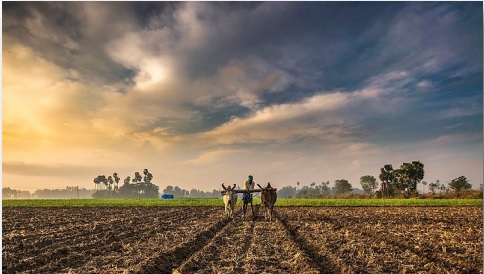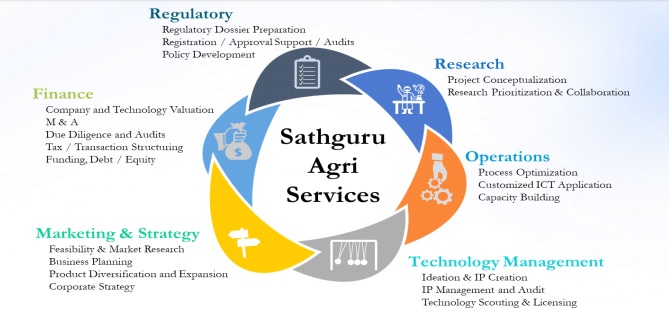

The lockdown imposed to fight against the deadly threat of COVID19 has disrupted the agri value chain significantly and there have been growing concerns among the stakeholders regarding negative implications of the pandemic on the farm economy. Problems are colossal, with this being the peak time for Rabi (winter) season harvests for crops like wheat, pulses and oilseeds among others followed by procurement through various government appointed agencies and other private entities. The farmers have been hoping for bumper benefits this Rabi season, but the unprecedented situation have dwindled the hopes of the farmers.
The Central and State governments have taken a series of steps to minimize the losses without compromising on the terms of lockdown and to provide requisite compensation to the farmers. The Indian Council of Agricultural Research (ICAR) has issued state wide advisories for specific practices to be adopted during harvest, threshing, post- harvest, storage and marketing of farm produce. Agricultural Ministry has started All India Transport Call Center for coordinating interstate movement of agricultural produce and resolve issues faced by various stakeholders. As per new guidelines issued, April 20th on wards the government have exempted various operations including agricultural, horticultural, farming, procurement of agri products, ‘mandis’ from lockdown. Shops of farm machinery, its spare parts, supply chain, repairs,’Custom Hiring Centers’ related to machinery will also remain open.
Farmers are facing the brunt of delayed and hampered harvest operations and inept post-harvest handling with reverse migration of farm laborers and workers as a result of lockdown restrictions. With the Rabi harvests on the verge of completion across the country, farmers are staring at the challenges of marketing the produce with disrupted transportation and restrictions on daily purchase quota from each farmer. However, as per the recent state reports, the key producing states are reporting relatively high procurement volumes, with the production of wheat likely to be 118.4 million tonnes as against the second advance estimates of wheat output of 106.21 million tonnes. Farmers are expected to incur losses due to staggered sales, storage concerns due to delayed sales and added transportation and labor costs on account of multiple handling.
Although agricultural activities are excluded from purview of lockdown as the nation needs to be fed, the on and off-farm agricultural activities are adversely affected to larger extent with shutdown of ancillary industries. The supply chain is severely affected with the limited transportation avenues leading to increased logistics expenses despite government measures on transport of agricultural produce by also looping Indian railways. Further, the procurement of the Rabi crops are likely to be disturbed with transportation costs expected to increase the burden of transporters as toll are being charged from April 20 onwards, which constitute almost 16 – 20% of the operating costs. In light of poor demand and minimal freights, this burden will be very hard to bear.
To comply with the social distancing norms, the State governments have significantly increased procurement centers and fixed on a daily purchase quota for each farmer to avoid overcrowding during the procurement season, which may extend up to early July. In many states, due to staggered procurement systems, the produce have already witnessed fall in prices below Minimum Support Prices (MSP’s). As per the permits, farmers should move with their harvests on specified dates and at specified timing for contract sales at markets. The state authorities in Punjab, Haryana have started issuing permits to farmers for carrying produce to market. This is expected to be realized across other states too. Further the government has approved warehouses as direct selling point so that farmers’ heavy transportation costs are reduced to some extent.
There is sudden spike in prices at the consumer end whereas the farm gate prices have plummeted. The increasing demand from middle class as well as urban and rural consumers and disrupted supply in mobilizing agricultural goods especially perishable commodities have affected all actors across the agricultural value chain.

As movement of migrant labors back to their hometowns has affected on farm agricultural operations, it has also severely affected the post-harvest operations and food processing industry.
The postharvest processors are running at very low capacity due to shortage in manpower, agri-based raw material, packaging material and other ancillary industries.
Addressing the current challenges in agricultural supply chain is the priority for government for smooth running of agri value chain and food processing industry. The government has declared an INR 1.7 trillion package, mostly to protect the vulnerable sections (including farmers) from any adverse impacts of the Corona pandemic. In addition to this, RBI has announced a moratorium on agricultural term loans (including crop loans) for a period of three months. There has also been relaxation in inter-state and intra-state movement of agricultural labors and farmers by the government to keep running the agricultural activities. E-commerce and delivery platforms needs to be further encouraged while following the guidelines on COVID-19.
All these efforts by the numerous farmers coupled with timely government interventions and exemptions have been able to have reduced impact on the overall supply chain of agriculture despite disruptions across the harvesting season which is essential in maintaining the food security of the nation. Despite all these challenges and measures taken, actors across the agricultural supply chain need to fight the battle against COVID-19 and work efficiently during these challenging times to feed the population taking necessary precautions as per the government guidelines. Further, to curtail the negative impacts of the lockdown, steps need to be taken through region wise intricate review and for proposing appropriate customized measures.

The current lockdown due to the Covid-19 crisis has put tremendous pressure on the farmers due to the harvesting of the Rabi crops. To support the farmers in these difficult times, the Ministry of Agriculture is promoting the pan-India electronic National Agricultural Marketplace, eNAM, created for unified national market for agricultural commodities which was introduced 4 years ago. Instead of the physical mandis, the eNAM portal allows the farmers to sell their produce to traders through a bidding process on the online mandis across India. The Ministry has also allowed FPOs to sell directly through eNAM either from their warehouses or from farmer producer organizations (FPO) directly from the farms. Also, additional 415 mandis have been added to the portal to the existing 585 mandis across 16 States and 2 Union territories in India. Currently more than 1.66 crore farmers and 1.28 lakh traders are registered on the eNAM portal. The transparency in the trade transactions, quality matching price and fair pricing are making it a popular choice amongst the farmers and traders. Further to promote eNAM and provide relief to the farmers during this crisis, the Ministry of Agriculture, has taken action to ease and regularize the sales of produce and make the supply chain more agile. The introduction of software modules like the Negotiable Warehouse Receipt (e-NWRs) module and FPO training modules to facilitate direct pickup of the produce from their collection centers. The Kisan Rath app which has the logistic module introduced recently facilitates seamless inter-mandi and inter-state transport of the produce with traceability function. It also features a list of large logistics aggregators to enable the traders to use their facilities. Currently more than 1.9 lakh transporters and over 7.76 lakh trucks are available on the application. While booking through the app the features like negotiations on the fare, loading and unloading are provided. Farmers can also hire machineries through this application. Increasing the pickup points and lowering the threshold carried by the transport, will encourage more and more farmers to use this facility.
Although eNAM has been around, very few states had adopted it. But with the need to maintain social distancing due to COVID-19 pandemic, this initiative is gaining popularity. If all the State Governments waive the mandi fees for FPOs on the eNAM portal, it will greatly facilitate moving this trade to online platform. The increasing popularity of the portal can be easily judged by the interstate trade of 20 commodities online including cereals, vegetables, pulses, spices, etc. in 16 states/union territories (including Uttar Pradesh, Uttarakhand, Andhra Pradesh, Telangana, Rajasthan, Gujarat, Maharashtra, Madhya Pradesh, Chandigarh, Himachal Pradesh, Haryana, Jharkhand & Tamil Nadu).

COVID-19 has introduced multiple unknowns for the agriculture industry, including the availability of labor, consumer demand, and the supply chain for inputs. In this context, adoption of ICT tools at a large scale is necessary for the farmers to access vital services. In today’s scenario, farmers across the country can receive updates about the status of their crop, essential parameters such as weather, information about buyers, sellers, and other service providers all happening however, need to be scaled up through public and private investment.
The government’s e-NAM (National Agriculture Market) platform to strengthen agriculture marketing for farmers, including the collectives, is an initiative in the right direction. Integrating it with Artificial Intelligence (AI) and other predictive models will be a long term and sustainable solution. Technology in agriculture can be considered as an essential input that can influence crop productivity, postharvest operations, marketing and improved profitability for all stake stakeholders. Today, AI systems are helping farmers to improve harvest and yield, both qualitatively and quantitively, using precision agriculture. It leverages AI in identifying pests and diseases in plants, and nutrition and water deficiency and/or any other stresses that can reduce crop productivity. AI solutions range from processing algorithms, drones, robots and intelligent monitoring systems to on-farm sensors with the applications. Adoption of drone technology in agriculture can lead to process simplification and enhanced productivity both in terms of quality and quantity. Because of this, AI is promising to become part of the agriculture industry’s technological tools. For example, Plantix app uses AI to identify plant diseases, pests, and nutrient deficiencies. Apart from this, it also helps fight crop losses and unnecessary or wrong use of pesticides. Today, the Plantix app is used by more than 10 million users in India on a yearly basis. Plantix also gives recommendations to farmers to find the right product, disease alerts and thus help farmers to fight the disease.
But the adoption of such technology driven solutions will depend on the investment that the government and other stakeholders put to make farmers digitally literate. COVID-19 has demonstrated the need and the opportunity to invest in such options. India’s national AI strategy also identifies agriculture as one of the key areas where AI can enable development and greater inclusion. This could have a positive impact on the agricultural economy and environmental sustainability. Therefore, it’s important to build the capacity of famers about the latest advancements in technologies and also ensure that these technologies are used to improve the quality of the produce and for better livelihood. Also, at the same time it is important to validate the emerging AI applications as the risk cannot be predicted easily in agriculture industry.
We hope that the agricultural sector will continue to see the stable implementation of AI and change continuously according to the recent trends of AI. This will help in improving the livelihood of farmers, strengthen agricultural communities and thus ensuring food in our plates.
News
International Rice Research Institute (IRRI) and AgriPlex Genomics partner to enhance genotyping in rice breeding to shorten the breeding cycles and improve quality controls by combining the innovative PlexSeqTM NGS platform with the high quality markers. As a part of the agreement, AgriPlex will become a member of the IRRI-led Hybrid Rice Development Consortium and will have a non-exclusive access to the SNP panels and DNA makers developed. Read More
Bayer has joined hands with Pune-based e-commerce firm, Agrostar to deliver farm inputs at farmer’s doorstep. This service is available with farmers of North, West and Central India as of now and Bayer plans to extend this home delivery service to rest of the country in future. This collaboration has been done amid lockdown due to COVID-19 as partial closure of agri-input shops. Read More
Corteva Agriscience licenses the on-demand pollination technology of PowerPollen, an Iowa-based ag tech company that developed the first and only scalable pollination technology for commodity crops to overcome the challenges associated with pollination and to enable increased flexibility and productivity for commercial corn seed production. Read more
New milestone in Nissan and Gowan partnership. After exclusive distribution rights in UK (2016), from April 1st 2020, Gowan exclusively distributes Nissan’s range of products (Pyridaben, Halosulfuron, Quizalofop PEthyl and Amisulbrom) in the Italian markets. Read more
Weed management is a critical component of agronomic crop production systems. Herbicides are widely used to provide weed control to ensure that yields are maximized. Overreliance on herbicides with a similar mode of action can rapidly lead to development of herbicide resistance in weeds. Researchers at Rothamsted Research have successfully adapted genetic techniques developed for crop improvement to be used in weeds to directly study the genetics responsible for herbicide resistance. Read more
ZeaKal, Inc. is a next generation seed trait technology company focusing on increasing the photosynthetic capacity of plants. Using their trademark PhotoSeed™ technology, improved soybean oil and protein composition without any yield penalty. This will help address the demands in a key crop, while securing soybeans as a major component of the regenerative agricultural system. Read more
Calyxt, a plant-based technology company has licensed a new method to help increase plant gene editing efficiency from the University of Minnesota. The method has the potential to reduce the time needed to edit plants from approximately one year to several months. Such technologies help to bring the consumer desired products to the market faster. Read more
An alternative high-precision dimeric Cas-CLOVER gene editing technology has undetectable off-target activity. CRISPR/Cas9 uses a single guide RNA which has been shown to create “off targets” mutations or genomic cuts in unwanted sites. Hera Bio Labs developed an alternative high-precision dimeric Cas-CLOVER gene editing technology which is functionally similar to CRISPR-Cas9 but uses a different nuclease protein called Clo51. Compared to CRISPR-Cas9, it demonstrates higher fidelity with no detectable off-targets while maintaining robust editing efficiency. Read more
Sathguru offers a whole spectrum of services for the Agri-input companies

Click here to Download the PDF version
Authors:




Connect with Authors at: E-mail agribusiness@sathguru.com
 Grow Beyond
Grow Beyond 

